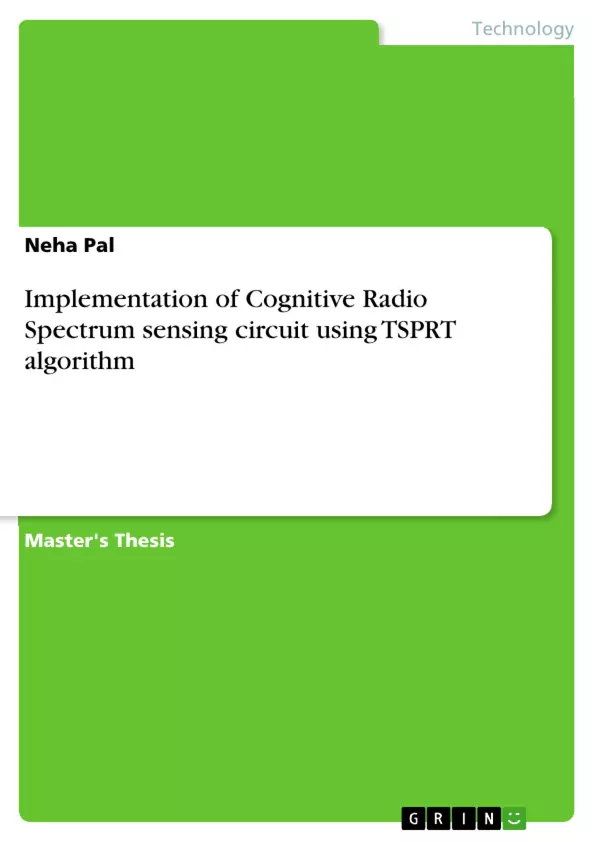To ensure that cognitive radios would not interfere with primary users, spectrum sensing is required to be efficient and accurate by reliably detecting primary user signals. In this work, we implemented a spectrum sensing methodology based on the Truncated Sequential Probability Ratio Test (TSPRT). The TSPRT is a combination of SPRT and Neyman-Pearson. We created and simulated the model and observed the variation of quantization error, noise variance and dynamic range of the signal to achieve the minimum average sample number (ASN) and desired error probabilities of detection and false alarm for sine wave and similar input signals. This report comprises of theoretical analysis and practical implementation of spectrum sensing circuit in Xilinx system generator. Simulations are done to observe the effect of various parameters on ASN and shown.
Inhaltsverzeichnis (Table of Contents)
- 1. Introduction
- 2. Background
- 2.1 Cognitive Radio Overview
- 2.2 Spectrum Sensing
- 2.2.1 Matched Filter
- 2.2.2 Cyclostationary Feature Detector
- 2.2.3 Energy Detector
- 2.2.4 Auto-correlation Based Detector
- 2.2.5 Cooperative Detector
- 2.3 Literature Survey
- 2.3.1 Binary Hypothesis
- 2.3.2 Neyman-Pearson Test
- 2.3.3 Sequential Test
- 2.3.4 Sequential probability Ratio Test (SPRT)
- 2.3.5 Truncated Sequential probability Ratio Test (TSPRT)
- 3. SIMULINK
- 3.1 Introduction to SIMULINK
- 3.2 Flow chart describing model
- 3.3 SIMULINK model
- 4. Xilinx Implementation Implementation
- 4.1 Brief about FPGA
- 4.2 Introduction to system generator in XILINX
- 4.3 Process Flow
- 4.4 Xilinx Model
- 5. Results and Analysis
- 5.1 ADC bit variation and its effect on ASN
- 5.2 Variation of noise parameter σn
- 5.3 Effect of q/o and dynamic range of signal
- 5.4 Detecting false alarms
- 6. Conclusion
- 7. Limitations and Future Work
Zielsetzung und Themenschwerpunkte (Objectives and Key Themes)
This dissertation explores the implementation of a spectrum sensing methodology based on the Truncated Sequential Probability Ratio Test (TSPRT) for cognitive radio applications. The primary objective is to develop an efficient and accurate spectrum sensing circuit that reliably detects primary user signals while ensuring minimal interference. The study investigates the impact of various parameters, such as quantization error, noise variance, and dynamic range, on the performance of the TSPRT algorithm, aiming to achieve optimal detection and false alarm probabilities with minimal average sample number (ASN).
- Cognitive Radio and Spectrum Sensing
- Truncated Sequential Probability Ratio Test (TSPRT)
- Spectrum Sensing Circuit Implementation in Xilinx System Generator
- Performance Evaluation of the TSPRT Algorithm
- Impact of Parameters on Average Sample Number (ASN) and Error Probabilities
Zusammenfassung der Kapitel (Chapter Summaries)
- Chapter 1: Introduction: This chapter introduces the concept of cognitive radio and its need for efficient spectrum sensing. It outlines the research problem and the proposed solution based on the TSPRT algorithm.
- Chapter 2: Background: This chapter provides a comprehensive overview of cognitive radio technology, focusing on spectrum sensing techniques. It reviews various detectors, including matched filter, cyclostationary feature detector, energy detector, auto-correlation based detector, and cooperative detector. It further delves into the theoretical foundations of hypothesis testing, Neyman-Pearson test, sequential test, and the SPRT and TSPRT algorithms.
- Chapter 3: SIMULINK: This chapter discusses the use of SIMULINK for modeling and simulating the spectrum sensing circuit. It presents a flow chart describing the model and details the implementation of the SIMULINK model.
- Chapter 4: Xilinx Implementation Implementation: This chapter describes the implementation of the spectrum sensing circuit on a Xilinx FPGA. It introduces FPGA technology and the system generator in XILINX, explaining the process flow and the Xilinx model.
- Chapter 5: Results and Analysis: This chapter presents the results of simulations conducted to analyze the performance of the implemented TSPRT algorithm. It examines the impact of ADC bit variation, noise parameter σn, q/o ratio, and dynamic range of the signal on the ASN and error probabilities.
Schlüsselwörter (Keywords)
Cognitive radio, spectrum sensing, Truncated Sequential Probability Ratio Test (TSPRT), Xilinx System Generator, FPGA, average sample number (ASN), detection probability, false alarm probability, quantization error, noise variance, dynamic range.
- Quote paper
- Neha Pal (Author), 2012, Implementation of Cognitive Radio Spectrum sensing circuit using TSPRT algorithm, Munich, GRIN Verlag, https://www.grin.com/document/352324



